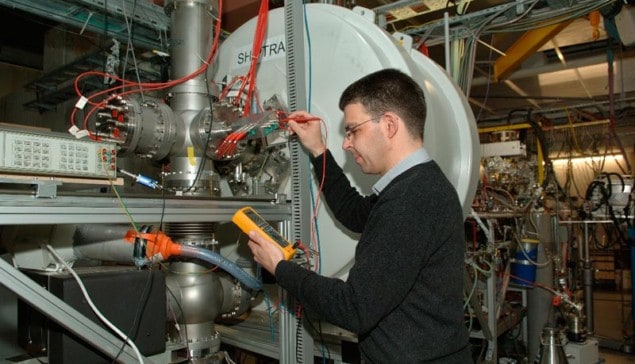
Researchers in Europe have made a key breakthrough in fundamental nuclear physics by making the first direct mass measurement of an element heavier than uranium. They say that their new technique will provide experimentalists with much better understanding of the superheavy elements, and it may even provide a stepping stone to the fabled “island of stability” – a hypothesized group of superheavy elements with much longer half-lives than uranium.
The element in question is nobelium (No), defined by its 102 protons, which the researchers produce by firing isotopes of calcium at a lead target. By fusion, this process produces one isotope every second of either 252No, 253No or 254No.
A major challenge that faced the researchers was to find a way of slowing down the energetic young nobelium ions to get them under control for their weigh-in. This was achieved by guiding them through a cloud of neutral helium atoms, which forced the sprightly ions to shed much of their energy through a series of collisions.
The weigh-in
At the weigh-in itself, nobelium isotopes were led into a vacuum chamber encasing powerful magnetic fields, called a “Penning trap”. Once inside the trap, the charged isotopes got picked up in the magnetic field lines and their masses were determined by the frequency at which they circulated. “The trick is to catch the particles in a trap that provides a clean environment,” says Michael Block, one of the researchers at the GSI heavy-ion research lab in Germany.
By comparing their results with the latest theoretical predictions, Block and his colleagues declare that their results are accurate to a precision of 0.05 parts per million and confirm previous results from indirect measurements. Before this research, the only way to gauge the mass of elements heavier than uranium was to study their decay products and “back track” to the parent isotope by a series of calculations.
“It is indeed a step change to make direct mass measurements for elements heavier than uranium,” says Philip Walker, a nuclear physicist at the University of Surrey. Walker believes that improved accuracy and reduced likelihood of systematic errors are the two main advantages.
Catch them while you can
The main challenge in the study of trans-uranium elements is to catch them while you can, as the isotopes are hard to produce and tend to have very short half-lives. The reason for their fleeting existence is that the large number of protons and neutrons crammed into their nuclei tends to leave them highly unstable and prone to fission.
Theoreticians predict, however, that as even heavier elements are discovered, we should eventually reach an “island of stability” around proton number 120 and neutron number 184. According to the theory, this geological feature in the sea of heavy isotopes would exist because certain “magic numbers” lead to stronger nuclear binding between protons and neutrons, the effect being related to the shells they occupy in the nucleus.
Block and his team intend to further improve their technique to determine the masses of heavier elements. “We are still a long way from reaching this island of stability, but it will be important to build a detailed picture of the radioactive elements along the way,” he told physicsworld.com.
This research was published in Nature.



